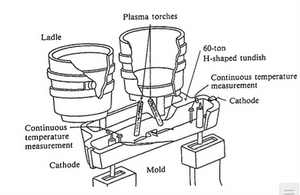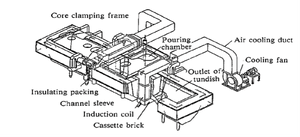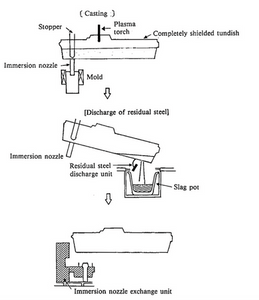Innovative tundish technology involves:
- Higher tundish capacity.
- Steel heating technology for quality improvement on a mass scale.
- Hot turnaround of tundishes.
- Composition adjustments by additions (e.g alloy additions) in the tundish.
Steel heating technology
The development of tundish steel heating technology prevents dead zones and low temperature chocking. Recently a high capacity plasma heater and induction heater have been installed for the purpose of precisely controlling the molten steel temperature that is directly linked with the stabilization of caster operation.
Plasma heating
It lends a higher degree of superheat control with the help of a rapid heating system and provides a contamination-free environment. Surface quality improved in steel and NMI and pinhole formation decreased by the use of plasma technology.
Plasma heater has two-phase plasma torches that are installed at the longitudinal center of the second vessel. It consists of two water-cooled copper electrodes. Heating is achieved by means of radiative and convective heat transfer. Temperature inflow into the bath is achieved by establishing a connection between the anodic torch and the cathodic metal bath. The arc gap ranges from 150-350 mm range depending on the power applied. Due to the compact nature, installation is easy and is less prone to refractory wear, reoxidation, and carbon pickup. But it picks up nitrogen during the process of ionization and dissociation of gas.
Plasma heating can control the temperature variation to less than 5 oC between heats during ladle change. Plasma heating can prevent SEN clogging in low-temperature casting and liquid circulation in the bath can contribute greatly to quality improvement.

Induction Heating
The tundish consists of molten steel inlet and outlet chambers. The two chambers are linked by a refractory sleeve. The molten steel is induction heated by inducing a current in the liquid steel from the magnetic flux generated when voltage is applied to the coils. The sleeve is made of alumina spinel refractory to assure fireproof and erosion resistance and to include electromagnetic induction. To prevent transmission of the induced current to the tundish shell a nonmagnetic stainless steel portal is inserted into the shell. Core and coil are separated from the tundish with the help of insulating material. The induction heating input power is automatically controlled by the feedback of the tundish steel temperature in the outlet chamber. The difference between inlet and outlet chamber steel temperature and that between the chamber steel temperature and the ladle steel temperature increase with increasing induction heating input power. The heating efficiency is 40% for the inlet chamber, 50% for the outlet chamber and can be as high as 90% for the total. Induction heating increases the tundish steel temperature and improves the steel cleanliness. The excellent performance can be attributed to the flotation of inclusion by rising streams formed with induction heating and to the removal of inclusion by electromagnetic forces generated by induction heating.

Hot turnaround of Tundish
Tundish hot turnaround equipment can improve the quality of nonsteady state casting and drastically reduce the tundish cost, and eliminate the dangerous, dirty, difficult, tasks associated with tundish maintenance. The figure shows the flow of tundish hot turnaround work. After the casting is completed residual steel in the tundish is removed. The SEN is oozed out by the tundish stopper and is replaced by a new SEN using an SEN exchanger. Tundish maintenance is done in a simple flow pattern.
Advantage of Hot turn around of tundish:
Complete elimination of preheating-This system made it necessary to develop a technique to quickly change the SEN that is preheated to upto1300oC. A mortar having high-temperature properties and making various SEN exchange device.
- Protection of molten steel against oxidation with integral SEN and completely shielded tundish.
- This system prevents air infiltration and abolishes the use of tundish insulating material.
- A rapid removal of residual steel and slag.
- The unit discharges the residual steel and empties the tundish within two minutes by operating a flapper installed on the tundish bottom

Chemistry adjustment by means of alloy addition in the induction heating tundish is advantageous in the case of large tundish. This has helped to achieve better homogeneity in the steel and conform to the strict requirement of composition. When a bulk ferroalloy is added into the tundish steel oxygen content will increase but due to the stirring effect of induction heating total oxygen content gradually reduces and produces highly clean steel. Small lot production is also liable to involve the hydrogen pickup and nitrogen pickup from the tundish refractory and alloy additions. This problem is minimized by reducing the moisture content of refractory and bath surface coverage with tundish flux.



